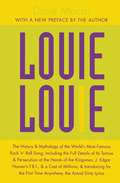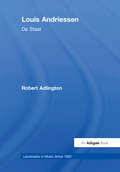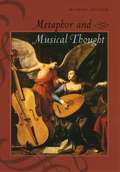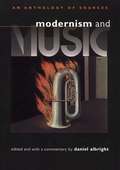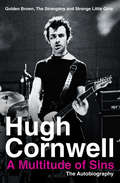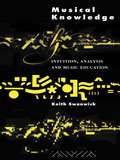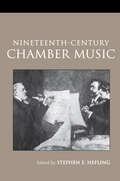- Table View
- List View
Louie Louie: The History and Mythology of the World's Most Famous Rock 'n Roll Song; Including the Full Details of Its Torture and Persecution at the Hands of the Kingsmen, J. Edgar Hoover's FBI, and a Cast of Millions; and Introducing for the First Time Anywhere, the
by Dave MarshA new edition of Dave Marsh's classic work on the three-chord song that rocked the world "A tale as compelling as any John Grisham thriller." -Rolling Stone "Dave Marsh's Louie Louie is part rant, part rock criticism and part cultural analysis, with a good dose of Ripley's Believe It or Not! thrown in." -The New York Times Book Review "Marsh keeps the story of one trashy song interesting by revealing how 'three chords and a cloud of dust' contains within it the history and future of rock 'n' roll." -Booklist "What you don't know about 'Louie Louie' probably won't hurt you. But everything you need to know is in Marsh's book, including the lyrics-the real ones and the ones people thought they heard. If there is a better measure of your pop-cultural IQ, I don't know where to find it." -USA Today Since his days as the original editor of Creem, Dave Marsh has been revered as one of rock's greatest critics. During the 70s he was record editor at Rolling Stone, and in 1983 he founded Rock & Roll Confidential. His other books include Glory Days: Bruce Springsteen in the 1980s (1987), and Before I Get Old: The Story of the Who (1983).
Louis Andriessen: De Staat
by Robert AdlingtonLouis Andriessen is one of the foremost composers in the world today. His music, with its distinctive blend of jazz, minimalism, Stravinsky and the European avant-garde, has attracted wide audiences internationally and made him a sought-after teacher among younger generations of composers. De Staat ('The Republic') brought Andriessen to international attention in 1976, and it remains his best-known work. This book is the first extended, single-author study of Andriessen in any language. It opens with a detailed account of Andriessen's involvement in the political upheavals of the 1960s and 1970s which formed the basis for his later views on instrumentation and musical style. The following chapters assess the principal influences on his music and the musical structure of De Staat. The book closes with an extensive discussion of the meaning of De Staat in the light of the composer's firmly held socio-political views. The downloadable resources include a thrilling live recording of De Staat from the 1978 Holland Festival, plus two earlier works not previously commercially available on compact disc - De Volharding and Il Principe.
Louis Andriessen: De Staat (Landmarks In Music Since 1950 Ser.)
by Robert AdlingtonLouis Andriessen is one of the foremost composers in the world today. His music, with its distinctive blend of jazz, minimalism, Stravinsky and the European avant-garde, has attracted wide audiences internationally and made him a sought-after teacher among younger generations of composers. De Staat ('The Republic') brought Andriessen to international attention in 1976, and it remains his best-known work. This book is the first extended, single-author study of Andriessen in any language. It opens with a detailed account of Andriessen's involvement in the political upheavals of the 1960s and 1970s which formed the basis for his later views on instrumentation and musical style. The following chapters assess the principal influences on his music and the musical structure of De Staat. The book closes with an extensive discussion of the meaning of De Staat in the light of the composer's firmly held socio-political views. The downloadable resources include a thrilling live recording of De Staat from the 1978 Holland Festival, plus two earlier works not previously commercially available on compact disc - De Volharding and Il Principe.
MacPherson's Rant: and Other Tales of the Scottish Fiddle
by Stuart McHardyThe fiddle has long played an important part in Scottish musical tradition. Here in MacPherson's Rant and Other Tales of the Scottish Fiddle there are stories that reflect that importance. Whether the fiddle is in the hands of the notorious Highland freebooter MacPherson or being played by a young man learning a fairy tune, these tales reflect a traditional culture that is still thriving. Some of the stories are truly ancient while others quite modern, but all show that throughout Scotland there has long been a ready audience for music made by horsehair on catgut. Today as Scottish culture continues to thrive in the face of all the modern world can throw at it we should perhaps think on what Robert Burns once did to a friend, 'Lang may yer elbuck, jink an diddle.' In addition to introducing some of the most famous, as well as some of the lesser-known, tales of the Scottish fiddle, Stuart McHardy also examines the history of the instrument, its repertoire and the place the fiddle and the fiddler have played in Scottish culture over the centuries. The result is a lively and informative companion to one of the central elements of the Scottish musical tradition.
Mercy, Mercy Me: The Art, Loves and Demons of Marvin Gaye
by Michael Eric DysonThe best-selling Motown artist of all time, Marvin Gaye defined the hopes and shattered dreams of an entire generation. Twenty years after his tragic death-he was shot by his father-his relevance persists because of the indelible mark his outsized talent left on American culture. A transcendent performer whose career spanned the history of rhythm and blues, from doo-wop to the sultriest of soul music, Gaye's artistic scope and emotional range set the soundtrack for America's tumultuous coming of age in the 1970s. Michael Eric Dyson's searching narrative illuminates Marvin Gaye's stellar ascendance-from a black church in Washington, D.C., to the artistic peak of What's Going On?-and charts his sobering personal decline. Dyson draws from interviews with those closest to Gaye to paint an intimate portrait of the tensions and themes that shaped contemporary urban America: racism, drug abuse, economic adversity, and the long legacy of hardship. Gaye's stormy relationships with women, including duet partner Tammi Terrell and wives Anna Gordy and Janis Hunter, are examined in light of the sexual revolution of the 1960s and 1970s. Dyson also considers family violence in the larger context of the African-American life and how that heartbreaking legacy resulted in Gaye's murder. Mercy, Mercy, Me is an unforgettable portrait of a beloved black genius whose art is reflected in the dynamism of contemporary urban America.
Mercy, Mercy Me: The Art, Loves and Demons of Marvin Gaye
by Michael Eric DysonTwenty years after his murder at the hands of his own father, Marvin Gaye continues to define the hopes and shattered dreams of the Motown generation. A performer whose career spanned the history of rhythm and blues, from doo-wop to the sultriest of soul music, Gaye's artistry magnified the contradictions that defined America's coming of age in the tumultuous 1970s. In his most searching and ambitious work to date, acclaimed critic Michael Eric Dyson illuminates both Marvin Gaye's stellar achievements and stunning personal decline -- and offers an unparalleled assessment of the cultural and political legacy of R&B on American culture. Through interviews with those close to Gaye -- from his musical beginnings in a black church in Washington, D.C., to his days as a "ladies' man" in Motown's stable of young singers, from the artistic heights of the landmark album What's Going On? to his struggles with addiction and domestic violence -- Dyson draws an indelible portrait of the tensions that shaped contemporary urban America: economic adversity, the drug industry, racism, and the long legacy of hardship. Published to coincide with the twentieth anniversary of Gaye's death in 1984, and infused with the soulful prose that has become Michael Eric Dyson's trademark, Mercy, Mercy Me is at once a celebration of an American icon whose work continues to inspire, and a revelatory and incisive look at how a lost generation's moods, music, and moral vision continue to resonate today.
Metaphor and Musical Thought (Women In Culture And Society Ser.)
by Michael Spitzer"The scholarship of Michael Spitzer's new book is impressive and thorough. The writing is impeccable and the coverage extensive. The book treats the history of the use of metaphor in the field of classical music. It also covers a substantial part of the philosophical literature. The book treats the topic of metaphor in a new and extremely convincing manner."-Lydia Goehr, Columbia University The experience of music is an abstract and elusive one, enough so that we're often forced to describe it using analogies to other forms and sensations: we say that music moves or rises like a physical form; that it contains the imagery of paintings or the grammar of language. In these and countless other ways, our discussions of music take the form of metaphor, attempting to describe music's abstractions by referencing more concrete and familiar experiences. Michael Spitzer's Metaphor and Musical Thought uses this process to create a unique and insightful history of our relationship with music—the first ever book-length study of musical metaphor in any language. Treating issues of language, aesthetics, semiotics, and cognition, Spitzer offers an evaluation, a comprehensive history, and an original theory of the ways our cultural values have informed the metaphors we use to address music. And as he brings these discussions to bear on specific works of music and follows them through current debates on how music's meaning might be considered, what emerges is a clear and engaging guide to both the philosophy of musical thought and the history of musical analysis, from the seventeenth century to the present day. Spitzer writes engagingly for students of philosophy and aesthetics, as well as for music theorists and historians.
Metaphor and Musical Thought
by Michael Spitzer"The scholarship of Michael Spitzer's new book is impressive and thorough. The writing is impeccable and the coverage extensive. The book treats the history of the use of metaphor in the field of classical music. It also covers a substantial part of the philosophical literature. The book treats the topic of metaphor in a new and extremely convincing manner."-Lydia Goehr, Columbia University The experience of music is an abstract and elusive one, enough so that we're often forced to describe it using analogies to other forms and sensations: we say that music moves or rises like a physical form; that it contains the imagery of paintings or the grammar of language. In these and countless other ways, our discussions of music take the form of metaphor, attempting to describe music's abstractions by referencing more concrete and familiar experiences. Michael Spitzer's Metaphor and Musical Thought uses this process to create a unique and insightful history of our relationship with music—the first ever book-length study of musical metaphor in any language. Treating issues of language, aesthetics, semiotics, and cognition, Spitzer offers an evaluation, a comprehensive history, and an original theory of the ways our cultural values have informed the metaphors we use to address music. And as he brings these discussions to bear on specific works of music and follows them through current debates on how music's meaning might be considered, what emerges is a clear and engaging guide to both the philosophy of musical thought and the history of musical analysis, from the seventeenth century to the present day. Spitzer writes engagingly for students of philosophy and aesthetics, as well as for music theorists and historians.
Metaphor and Musical Thought (Women In Culture And Society Ser.)
by Michael Spitzer"The scholarship of Michael Spitzer's new book is impressive and thorough. The writing is impeccable and the coverage extensive. The book treats the history of the use of metaphor in the field of classical music. It also covers a substantial part of the philosophical literature. The book treats the topic of metaphor in a new and extremely convincing manner."-Lydia Goehr, Columbia University The experience of music is an abstract and elusive one, enough so that we're often forced to describe it using analogies to other forms and sensations: we say that music moves or rises like a physical form; that it contains the imagery of paintings or the grammar of language. In these and countless other ways, our discussions of music take the form of metaphor, attempting to describe music's abstractions by referencing more concrete and familiar experiences. Michael Spitzer's Metaphor and Musical Thought uses this process to create a unique and insightful history of our relationship with music—the first ever book-length study of musical metaphor in any language. Treating issues of language, aesthetics, semiotics, and cognition, Spitzer offers an evaluation, a comprehensive history, and an original theory of the ways our cultural values have informed the metaphors we use to address music. And as he brings these discussions to bear on specific works of music and follows them through current debates on how music's meaning might be considered, what emerges is a clear and engaging guide to both the philosophy of musical thought and the history of musical analysis, from the seventeenth century to the present day. Spitzer writes engagingly for students of philosophy and aesthetics, as well as for music theorists and historians.
Metaphor and Musical Thought
by Michael Spitzer"The scholarship of Michael Spitzer's new book is impressive and thorough. The writing is impeccable and the coverage extensive. The book treats the history of the use of metaphor in the field of classical music. It also covers a substantial part of the philosophical literature. The book treats the topic of metaphor in a new and extremely convincing manner."-Lydia Goehr, Columbia University The experience of music is an abstract and elusive one, enough so that we're often forced to describe it using analogies to other forms and sensations: we say that music moves or rises like a physical form; that it contains the imagery of paintings or the grammar of language. In these and countless other ways, our discussions of music take the form of metaphor, attempting to describe music's abstractions by referencing more concrete and familiar experiences. Michael Spitzer's Metaphor and Musical Thought uses this process to create a unique and insightful history of our relationship with music—the first ever book-length study of musical metaphor in any language. Treating issues of language, aesthetics, semiotics, and cognition, Spitzer offers an evaluation, a comprehensive history, and an original theory of the ways our cultural values have informed the metaphors we use to address music. And as he brings these discussions to bear on specific works of music and follows them through current debates on how music's meaning might be considered, what emerges is a clear and engaging guide to both the philosophy of musical thought and the history of musical analysis, from the seventeenth century to the present day. Spitzer writes engagingly for students of philosophy and aesthetics, as well as for music theorists and historians.
Metaphor and Musical Thought
by Michael Spitzer"The scholarship of Michael Spitzer's new book is impressive and thorough. The writing is impeccable and the coverage extensive. The book treats the history of the use of metaphor in the field of classical music. It also covers a substantial part of the philosophical literature. The book treats the topic of metaphor in a new and extremely convincing manner."-Lydia Goehr, Columbia University The experience of music is an abstract and elusive one, enough so that we're often forced to describe it using analogies to other forms and sensations: we say that music moves or rises like a physical form; that it contains the imagery of paintings or the grammar of language. In these and countless other ways, our discussions of music take the form of metaphor, attempting to describe music's abstractions by referencing more concrete and familiar experiences. Michael Spitzer's Metaphor and Musical Thought uses this process to create a unique and insightful history of our relationship with music—the first ever book-length study of musical metaphor in any language. Treating issues of language, aesthetics, semiotics, and cognition, Spitzer offers an evaluation, a comprehensive history, and an original theory of the ways our cultural values have informed the metaphors we use to address music. And as he brings these discussions to bear on specific works of music and follows them through current debates on how music's meaning might be considered, what emerges is a clear and engaging guide to both the philosophy of musical thought and the history of musical analysis, from the seventeenth century to the present day. Spitzer writes engagingly for students of philosophy and aesthetics, as well as for music theorists and historians.
Metaphor and Musical Thought
by Michael Spitzer"The scholarship of Michael Spitzer's new book is impressive and thorough. The writing is impeccable and the coverage extensive. The book treats the history of the use of metaphor in the field of classical music. It also covers a substantial part of the philosophical literature. The book treats the topic of metaphor in a new and extremely convincing manner."-Lydia Goehr, Columbia University The experience of music is an abstract and elusive one, enough so that we're often forced to describe it using analogies to other forms and sensations: we say that music moves or rises like a physical form; that it contains the imagery of paintings or the grammar of language. In these and countless other ways, our discussions of music take the form of metaphor, attempting to describe music's abstractions by referencing more concrete and familiar experiences. Michael Spitzer's Metaphor and Musical Thought uses this process to create a unique and insightful history of our relationship with music—the first ever book-length study of musical metaphor in any language. Treating issues of language, aesthetics, semiotics, and cognition, Spitzer offers an evaluation, a comprehensive history, and an original theory of the ways our cultural values have informed the metaphors we use to address music. And as he brings these discussions to bear on specific works of music and follows them through current debates on how music's meaning might be considered, what emerges is a clear and engaging guide to both the philosophy of musical thought and the history of musical analysis, from the seventeenth century to the present day. Spitzer writes engagingly for students of philosophy and aesthetics, as well as for music theorists and historians.
Modernism and Music: An Anthology of Sources (Hopkins Studies In Modernism Ser.)
by Daniel AlbrightIf in earlier eras music may have seemed slow to respond to advances in other artistic media, during the modernist age it asserted itself in the vanguard. Modernism and Music provides a rich selection of texts on this moment, some translated into English for the first time. It offers not only important statements by composers and critics, but also musical speculations by poets, novelists, philosophers, and others-all of which combine with Daniel Albright's extensive, interlinked commentary to place modernist music in the full context of intellectual and cultural history.
A Multitude of Sins: Golden Brown, The Stranglers And Strange Little Girls
by Hugh CornwellAutobiography by the singer and creative force of 70s rock group The Stranglers.
Music and the Emotions: The Philosophical Theories (International Library of Philosophy)
by Malcolm BuddIt has often been claimed, and frequently denied, that music derives some or all of its artistic value from the relation in which it stands to the emotions. This book presents and subjects to critical examination the chief theories about the relationship between the art of music and the emotions.
Music and the Emotions: The Philosophical Theories (International Library of Philosophy)
by Malcolm BuddIt has often been claimed, and frequently denied, that music derives some or all of its artistic value from the relation in which it stands to the emotions. This book presents and subjects to critical examination the chief theories about the relationship between the art of music and the emotions.
The Music of Joonas Kokkonen
by Edward JurkowskiJoonas Kokkonen (1921-1996) has been one of the most performed Finnish composers during the past 25 years both within Finland and abroad.The author's study of Joonas Kokkonen is the first full-scale account in English. Starting with a brief survey of Finnish music during the 20th century, the book then devotes a separate chapter to each of the major genres in which Kokkonen composed: symphonic, orchestral, vocal, chamber and keyboard. Illustrated with over a hundred music examples, The Music of Joonas Kokkonen seeks to overturn his reputation in some quarters as a conservative, even old fashioned, composer, and argues that Kokkonen created an interesting and refreshing approach to dodecaphonic composition and pitch organization. With a full chronological listing of works and bibliography, this book is the most important reference source to date on Kokkonen and his music." "Book Description: One of the most performed Finnish composers during the last 25 years, Joonas Kokkonen (1921-1996) was also instrumental in the development of the nation's system of music education. In this study,the author (music, U. of Lethbridge, Canada) examines Kokkonen's compositions in each of five major genres: symphonic, orchestral, vocal, chamber, and key
The Music of Joonas Kokkonen
by Edward JurkowskiJoonas Kokkonen (1921-1996) has been one of the most performed Finnish composers during the past 25 years both within Finland and abroad.The author's study of Joonas Kokkonen is the first full-scale account in English. Starting with a brief survey of Finnish music during the 20th century, the book then devotes a separate chapter to each of the major genres in which Kokkonen composed: symphonic, orchestral, vocal, chamber and keyboard. Illustrated with over a hundred music examples, The Music of Joonas Kokkonen seeks to overturn his reputation in some quarters as a conservative, even old fashioned, composer, and argues that Kokkonen created an interesting and refreshing approach to dodecaphonic composition and pitch organization. With a full chronological listing of works and bibliography, this book is the most important reference source to date on Kokkonen and his music." "Book Description: One of the most performed Finnish composers during the last 25 years, Joonas Kokkonen (1921-1996) was also instrumental in the development of the nation's system of music education. In this study,the author (music, U. of Lethbridge, Canada) examines Kokkonen's compositions in each of five major genres: symphonic, orchestral, vocal, chamber, and key
The Music Practitioner: Research for the Music Performer, Teacher and Listener
by JaneW. DavidsonUseful work has been done in recent years in the areas of music psychology, philosophy and education, yet this is the first book to provide a wide assessment of what practical benefits this research can bring to the music practitioner. With 25 chapters by writers representing a broad range of perspectives, this volume is able to highlight many of the potential links between music research and practice. The chapters are divided into five main sections. Section one examines practitioners use of research to assist their practice and the ways in which they might train to become systematic researchers. Section two explores research centred on perception and cognition, while section three looks at how practitioners have explored their everyday work and what this reveals about the creative process. Section four focuses on how being a musician affects an individual‘s sense of self and the how others perceive him or her. The essays in section five outline the new types of data that creative researchers can provide for analysis and interpretation. The concluding chapter discusses that key question - what makes music affect us in the way it does? The research findings in each chapter provide useful sources of data and raise questions that are applicable across the spectrum of music-related disciplines. Moreover, the research methodologies applied to a specific question may have broader application for readers wishing to take on research themselves.
The Music Practitioner: Research for the Music Performer, Teacher and Listener
by JaneW. DavidsonUseful work has been done in recent years in the areas of music psychology, philosophy and education, yet this is the first book to provide a wide assessment of what practical benefits this research can bring to the music practitioner. With 25 chapters by writers representing a broad range of perspectives, this volume is able to highlight many of the potential links between music research and practice. The chapters are divided into five main sections. Section one examines practitioners use of research to assist their practice and the ways in which they might train to become systematic researchers. Section two explores research centred on perception and cognition, while section three looks at how practitioners have explored their everyday work and what this reveals about the creative process. Section four focuses on how being a musician affects an individual‘s sense of self and the how others perceive him or her. The essays in section five outline the new types of data that creative researchers can provide for analysis and interpretation. The concluding chapter discusses that key question - what makes music affect us in the way it does? The research findings in each chapter provide useful sources of data and raise questions that are applicable across the spectrum of music-related disciplines. Moreover, the research methodologies applied to a specific question may have broader application for readers wishing to take on research themselves.
Musical Knowledge: Intuition, analysis and music education
by Prof Keith Swanwick Keith SwanwickThe understanding of music involves the mastery of its various layers of meaning. Sometimes this meaning can be acquired through human insight; at other times, it can be learned. The central concern of Musical Knowledge is the tension between intuitive and analytical ways of making sense of the world. Keith Swanwick examines this relationship on three levels: in considering music as a way of knowing; as the apparent predicament between qualitative and quantitative research paradigms; and as a tension in education. Keith Swanwick guides his reader from a theoretical exploration of musical knowledge, through an examination of ways of researching the musical experience to a concluding section which will be of direct practical help to teachers. He suggests ways in which music education can be a vital transaction, giving examples across a range of music teaching, including school classroom and instrumental studios. The book will be of interest to anyone who makes or responds to music.
Musical Knowledge: Intuition, analysis and music education
by Prof Keith Swanwick Keith SwanwickThe understanding of music involves the mastery of its various layers of meaning. Sometimes this meaning can be acquired through human insight; at other times, it can be learned. The central concern of Musical Knowledge is the tension between intuitive and analytical ways of making sense of the world. Keith Swanwick examines this relationship on three levels: in considering music as a way of knowing; as the apparent predicament between qualitative and quantitative research paradigms; and as a tension in education. Keith Swanwick guides his reader from a theoretical exploration of musical knowledge, through an examination of ways of researching the musical experience to a concluding section which will be of direct practical help to teachers. He suggests ways in which music education can be a vital transaction, giving examples across a range of music teaching, including school classroom and instrumental studios. The book will be of interest to anyone who makes or responds to music.
Musical Metropolis: Los Angeles and the Creation of a Music Culture, 1880–1940
by K. MarcusDecentralization and diversity characterized much of the performance of art music in Los Angeles. Decentralization defined the city's growth since the late-nineteenth century, and because the central city did not dominate music culture, as in the East and Midwest, a greater diversification of music emerged in the communities of Greater Los Angeles. Performers and audiencesincluded Latinos, Euro-Americans, Asian Americans, and African Americans, but the notion of diversity goes beyond ethnicity; it also includes 'media diversity', the presentation of music through a variety of media. recording, radio, film media strongly influenced music performance in the city as it grew into the epicenter of entertainment in America.
Musik zwischen Emigration und Stalinismus: Russische Komponisten in den 1930er und 1940er Jahren
Russisches Musikleben nach der Oktoberrevolution 1917. Während zahlreiche Komponisten vor Stalin ins Ausland flohen, darunter Rachmaninow und Strawinsky, blieben andere im Land und etablierten dort eine eigene Traditionslinie. Der Band widmet sich erstmals umfassend der Spaltung der russischen Musikkultur. Als Schlüsselfigur der Zeit zwischen 1930 und 1950 entpuppt sich dabei Prokofjew, der in die Sowjetunion zurückkehrte und beide Musikkulturen in sich vereinte.
Nineteenth-Century Chamber Music
by Stephen HeflingFirst Published in 2004. Routledge is an imprint of Taylor & Francis, an informa company.
